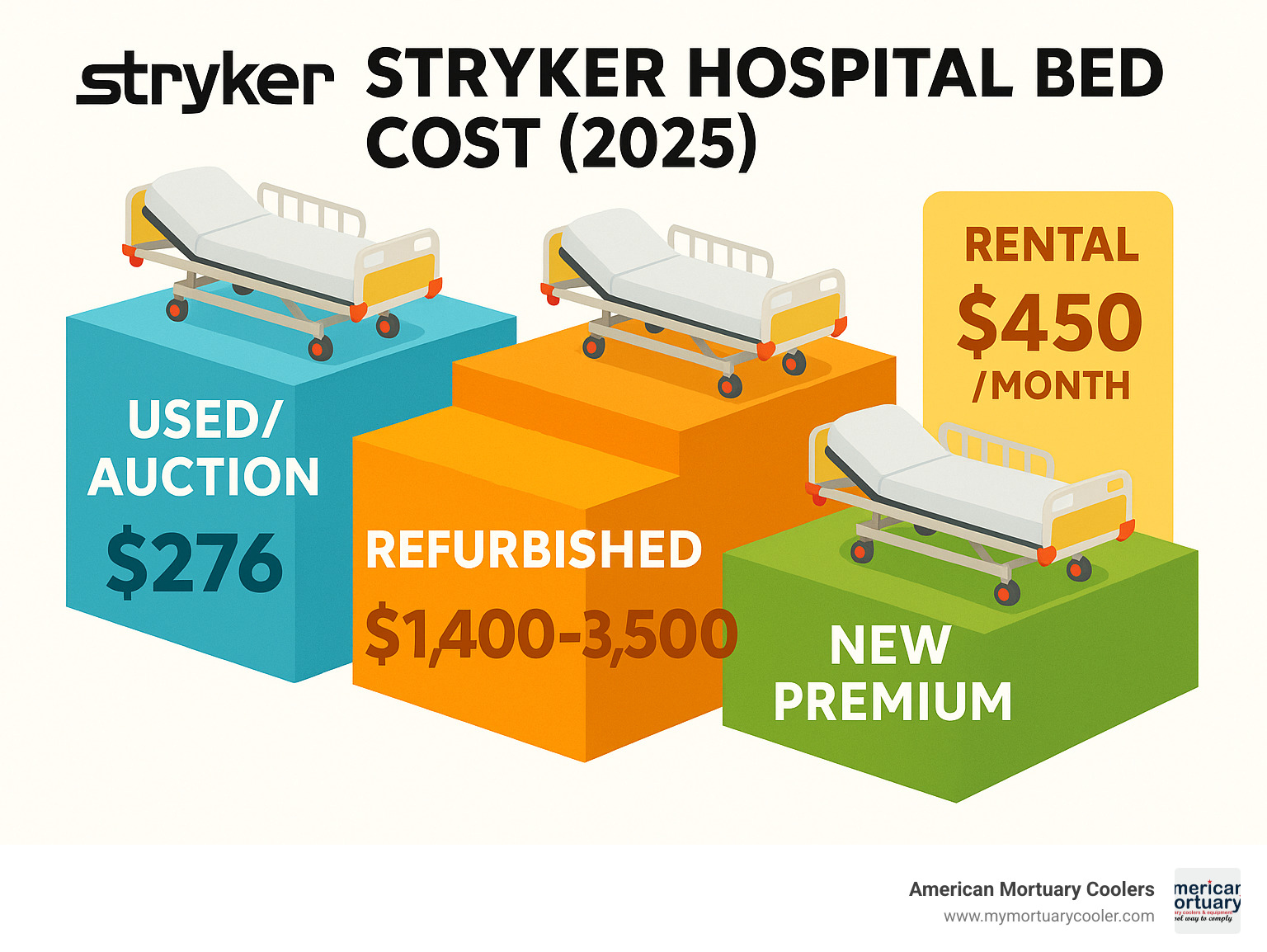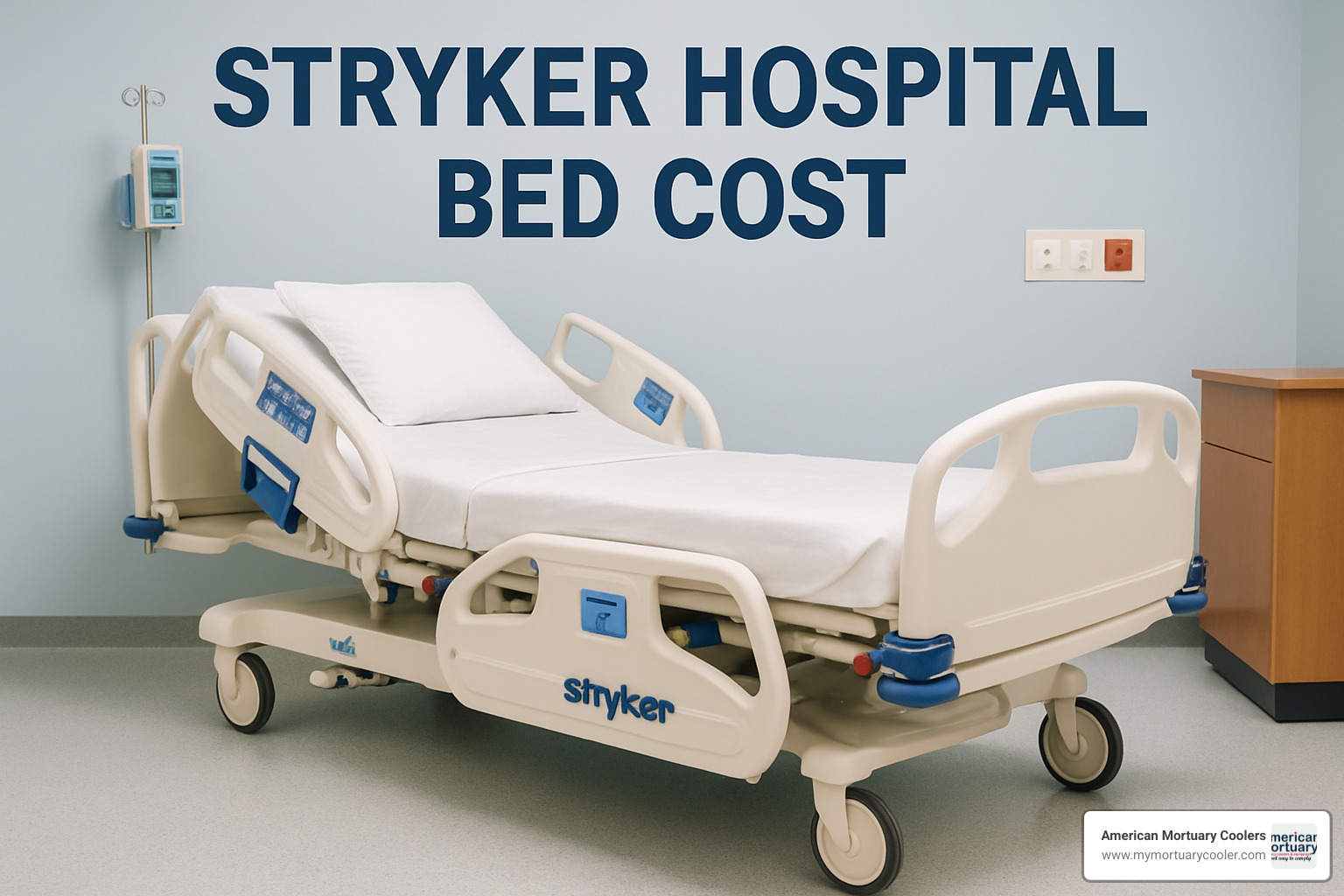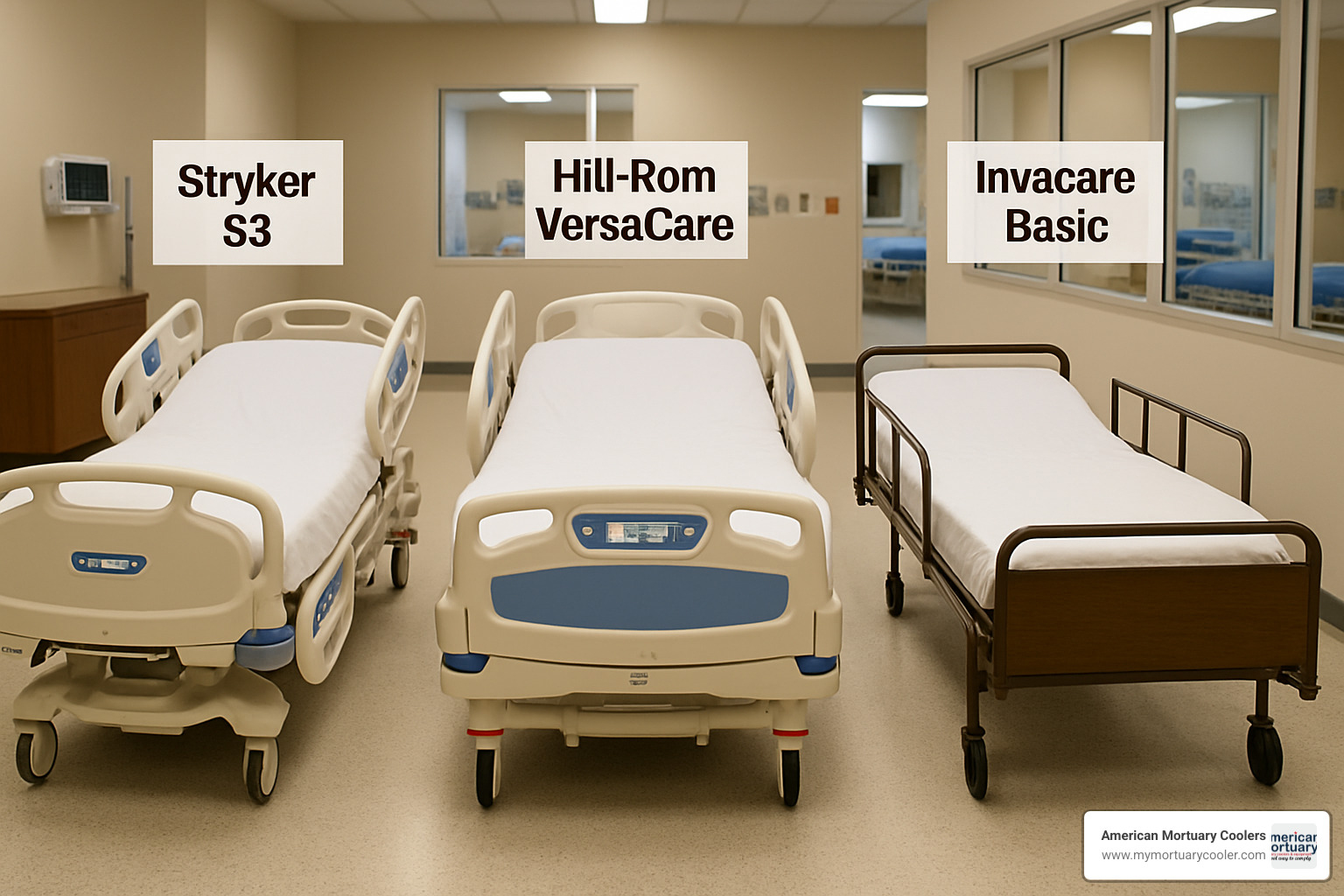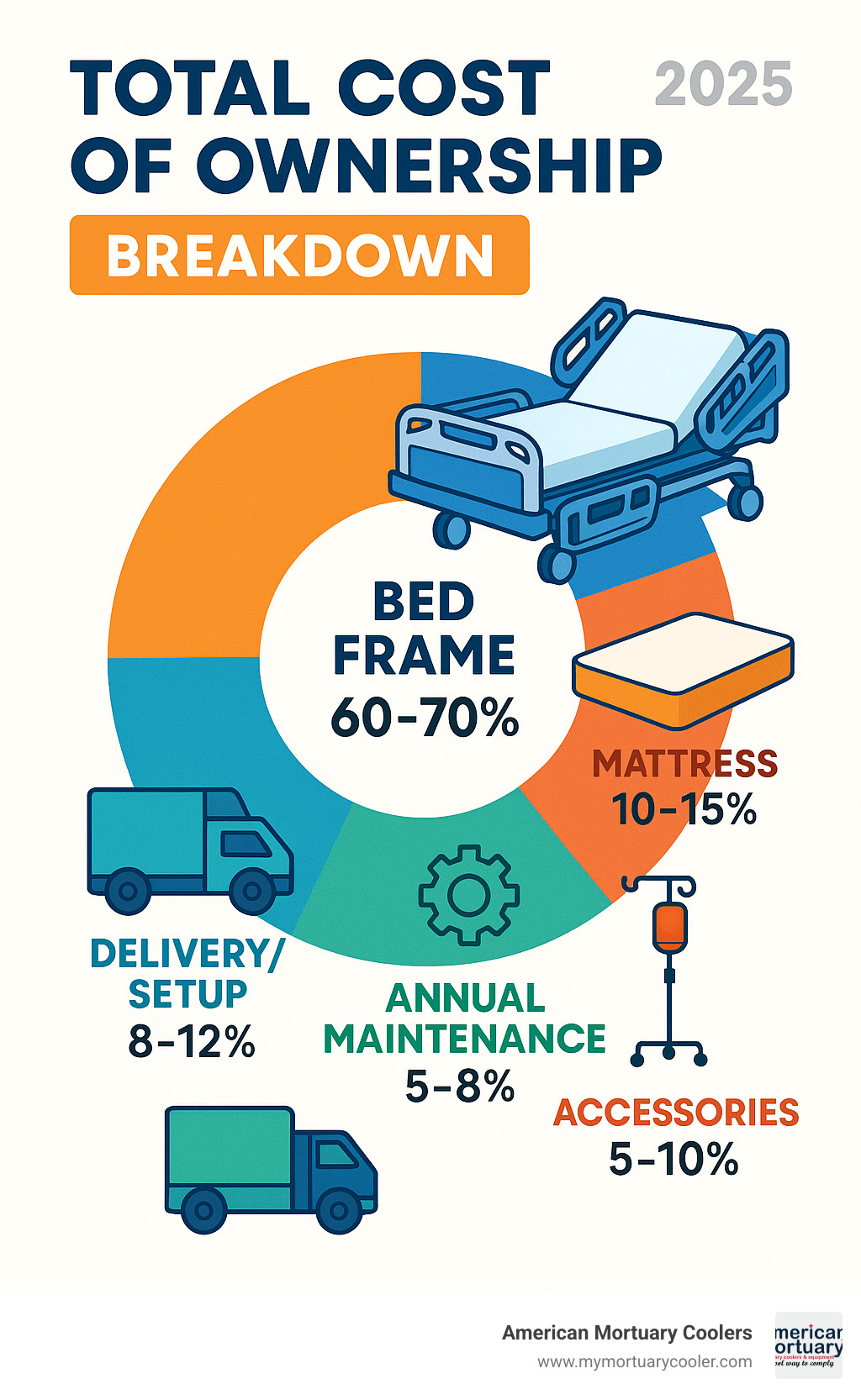
Beginner's Guide to Stryker Hospital Bed Costs
Understanding What You'll Pay for a Stryker Hospital Bed
Stryker hospital bed cost ranges from $276 for basic used models to $8,500 for new premium beds, with most buyers paying between $1,400-$3,000 for refurbished units that offer the best value.
Quick Price Overview:
- Used/Auction: $276 - $1,200
- Refurbished: $1,400 - $3,500
- New Premium: $4,000 - $8,500
- Monthly Rental: $450 - $3,550
Whether you're outfitting a medical facility, setting up home care, or planning a training lab, Stryker beds represent a significant investment. The wide price range reflects differences in model features, condition, and included accessories like integrated scales or advanced fall-prevention systems.
Understanding these costs upfront helps you budget properly and avoid surprise expenses like mattresses ($247-$600), delivery fees ($500-$850), or ongoing maintenance contracts. Many buyers focus only on the bed frame price and miss these additional costs that can add thousands to your total investment.
As healthcare equipment specialists, we've helped countless funeral directors and healthcare facilities steer medical equipment purchases, including analyzing Stryker hospital bed cost comparisons for multi-use facilities. Our experience sourcing durable American-made equipment has shown us how proper cost planning prevents budget overruns and delivery delays.

Average Stryker Hospital Bed Cost Breakdown
When you're shopping for a Stryker hospital bed, understanding the price landscape can save you thousands. The Stryker hospital bed cost varies dramatically based on whether you buy new, refurbished, or hunt for deals at medical equipment auctions.
New Stryker beds represent the premium end of the market, typically running between $4,000 and $8,500. These beds come fresh from the factory with full manufacturer warranties and the latest safety features. The ProCuity series sits at the top of this range, commanding premium prices for its wireless technology and advanced fall-prevention systems.
The sweet spot for most buyers? Refurbished models priced between $1,400 and $3,500. These beds have been professionally reconditioned and often include limited warranties that give you peace of mind. For example, you might find a refurbished Stryker Secure 3 for $1,995 with a 90-day warranty, or pay $2,995 for the same bed with a full year of coverage.
Auction and used beds offer the most budget-friendly entry point, with prices starting as low as $276 for basic Stryker Secure II models. However, these deals can climb to $1,200 depending on the bed's condition and included accessories. While the upfront savings are attractive, factor in potential repair costs when evaluating these bargains.
Monthly rentals average around $450, though premium configurations can reach $3,550 per month. This option makes sense for short-term rehabilitation needs or when preserving cash flow is your top priority.

Stryker Hospital Bed Cost for Premium Models (ProCuity, InTouch)
Stryker's ProCuity series represents the Rolls-Royce of hospital beds, and the Stryker hospital bed cost reflects this premium positioning. These beds pack cutting-edge wireless technology and comprehensive safety features that justify their higher price tags.
What makes ProCuity beds special? They're the industry's first completely wireless hospital beds, eliminating the cable management headaches that plague most facilities. The wireless connectivity maintains an impressive 99.99% connection reliability, so you won't lose critical patient monitoring data.
The adaptive bed alarm system automatically adjusts its sensitivity based on each patient's weight, position, and siderail configuration. This smart technology reduces false alarms while maintaining top-notch safety standards - a win-win for both staff and patients.
The InTouch 2141 model bridges the gap between basic beds and full ProCuity features, with marketplace pricing starting around $2,032. It includes wireless nurse call integration and basic fall-prevention monitoring without all the bells and whistles of the flagship models.
Stryker backs these premium beds with bold guarantees: 30% reduction in hospital-acquired pressure injuries, 50% reduction in falls, and 50% reduction in rental costs under specific contract terms. These guarantees show how confident they are in their technology's real-world performance.
Stryker Hospital Bed Cost for Core Med-Surg Models (S3, Secure II, GoBed II)
The core Stryker lineup delivers solid hospital bed functionality without breaking the bank. These models focus on essential features that most facilities actually use daily, making them smart choices for budget-conscious buyers.
The S3 series typically costs around $4,407 new or $1,995-$2,995 refurbished. Its standout feature is StayPut Technology, which keeps patients properly positioned when you raise the head of the bed. This reduces the need for constant repositioning - a real time-saver for busy staff.
The Secure II 3002 model offers excellent bang for your buck, with refurbished units starting at $1,400 for round-rail versions and $1,600 for square-rail models. These beds include integrated scales, bed exit alarms, and full electric adjustment with Trendelenburg positioning. The 500-pound weight capacity and 16"-30" height range handle most patient needs without issue.
GoBed II models represent the budget-friendly option, with marketplace listings starting around $415. These beds prioritize mobility and basic positioning over advanced monitoring features. They work well in skilled nursing facilities and home care settings where you need reliable functionality without sophisticated fall-prevention systems.
All core models include standard features like CPR release, IV pole receptacles, and four-wheel brake systems. The open architecture design plays nicely with various mattress systems and traction equipment without requiring additional hardware investments.
Key Factors That Influence Stryker Hospital Bed Cost
When you're shopping for a Stryker bed, the sticker price is just the beginning of your cost story. Several behind-the-scenes factors can swing your final Stryker hospital bed cost by thousands of dollars, and understanding these variables helps you budget smarter and avoid those "oops, I didn't see that coming" moments.
Feature complexity creates the biggest price jumps you'll encounter. A basic bed frame might seem reasonable until you add an integrated scale (hello, extra $500-$1,000) or wireless connectivity that can bump your cost up by $2,000-$3,000. While these features might feel expensive upfront, evidence-based fall-prevention data shows they're often worth every penny for facilities serving high-risk patients.
The condition and refurbishment level of your bed makes a huge difference in what you'll pay. Professional reconditioning isn't just a fancy term - it includes thorough electrical testing, cosmetic restoration, and replacing worn components. This attention to detail explains why properly refurbished beds cost 40-60% less than new ones while still delivering reliable performance.
Warranty coverage represents one of those "pay now or pay later" decisions. Extended warranties add $500-$1,000 to refurbished bed prices, but they protect you from expensive surprise repairs down the road. For critical care applications, this extra coverage often pays for itself with just one major repair.
Market demand and availability create pricing waves that smart buyers can ride. Popular models like the S3 and Secure II hold their value better because everyone wants them - they've earned their reputation for durability. You'll also notice seasonal price bumps when educational institutions stock up for training programs.
High-Tech Add-Ons That Drive Up Cost
Modern hospital beds pack more technology than some cars, and these high-tech features can increase your Stryker hospital bed cost by 50% or more. The good news? These aren't just expensive gadgets - they solve real problems that cost money in other ways.
iBed Wireless connectivity eliminates the cable chaos that drives maintenance teams crazy while providing real-time data on bed position, brake status, and alarm conditions. This wireless capability adds roughly $2,000-$3,000 to your bed cost, but it simplifies installation and reduces ongoing maintenance headaches that eat up staff time.
Zoom Motorized Drive turns your bed into a powered transport vehicle, letting one caregiver move patients through tight hallways and into elevators without breaking a sweat. At $1,500-$2,500, it's not cheap, but it dramatically reduces staff strain and keeps patient flow moving smoothly during busy periods.
Adaptive bed alarms use smart sensors to monitor patient movement and automatically adjust sensitivity levels. These systems add $800-$1,500 to your bed cost but practically eliminate those middle-of-the-night false alarms that exhaust nursing staff while maintaining genuine safety protection.
Integrated patient scales provide accurate weight measurements without transferring patients to separate scales. The convenience of one-touch weighing adds $1,000-$1,500 to your investment but improves workflow efficiency and keeps patients more comfortable during routine monitoring.
Hidden Costs Buyers Forget
Here's where many buyers get caught off guard - the Stryker hospital bed cost you see advertised rarely includes everything you actually need to get up and running. These "hidden" costs aren't really hidden, but they're easy to overlook when you're focused on the big-ticket bed price.
Mattress costs sneak up on buyers because most bed prices assume you'll provide your own. Basic foam mattresses start at $247, while advanced therapeutic surfaces can hit $600 or more. For specialized applications like pressure injury prevention or bariatric care, expect to pay even more. This seemingly small addition can bump your total cost up by 15-25%.
Delivery and installation fees typically run $500-$850 for standard shipments, though remote locations requiring private charter delivery cost significantly more. Professional installation and setup services add another $200-$500, but they ensure your bed is configured correctly and your staff knows how to use all the features safely.
Annual service contracts cost $500-$1,000 yearly but provide preventive maintenance, emergency repairs, and software updates for beds with electronic systems. While technically optional, these contracts extend your bed's lifespan and maintain warranty coverage on complex features that would be expensive to repair out-of-pocket.
Accessories and peripherals including IV poles, pump holders, and specialized siderails can tack on another $300-$800 to your purchase. Some accessories come standard with certain models, but others require separate ordering and installation - another detail that's easy to miss during initial planning.
Buying, Renting, or Financing: Which Path Lowers Your Stryker Hospital Bed Cost?
The smartest way to manage Stryker hospital bed cost depends on how long you'll need the bed and your cash flow situation. Think of it like choosing between buying a car, leasing, or taking an Uber - each makes sense in different circumstances.
Buying outright gives you the best bang for your buck if you're planning to use the bed for years. Stryker beds are built like tanks and typically last 10-15 years with proper care. A refurbished bed that costs $2,500 today will still have value when you're ready to upgrade, usually retaining 40-60% of its purchase price after five years.
Renting at $450 monthly makes perfect sense for short-term needs. If you're setting up temporary patient care or need beds for just a few months, rental wins hands down. But here's the catch - those monthly payments add up fast. After about 12-18 months, you've spent more on rent than you would have buying a good refurbished bed.
Financing spreads the cost over 3-7 years, which helps preserve your operating capital for other priorities. Some manufacturers offer promotional 0% financing that can actually make a new bed cheaper than a used one when you factor in warranty coverage and the latest safety features.
The math gets interesting when you consider that Stryker beds hold their value remarkably well. Unlike most medical equipment that becomes worthless after a few years, a well-maintained Stryker bed remains a valuable asset throughout its 10-15 year lifespan.
More info about financing options can help you explore payment structures that work with your budget cycles.
Cost Comparison Scenarios
Let's look at real situations where different approaches to Stryker hospital bed cost make financial sense.
Home care during recovery from surgery or illness typically lasts 3-6 months. Renting makes perfect sense here - you'll spend $1,350-$2,700 total, which beats buying a refurbished bed for $2,000-$3,000 plus delivery costs. Plus, the rental company handles maintenance and picks up the bed when you're done.
Long-term care facilities upgrading their equipment should almost always buy. A nursing home replacing 20 beds can save $20,000-$40,000 by choosing quality refurbished Stryker beds over new ones. That's real money that can go toward patient care or facility improvements.
The capital budget versus operational expense decision matters more than many people realize. Rental payments come out of your operating budget, which might be easier to manage month-to-month. But purchased beds can be depreciated over their useful life, providing tax advantages that rental can't match.
Training facilities and simulation labs often get the best value from refurbished beds. Students need hands-on experience with real equipment, but they don't need the latest wireless features. A refurbished Stryker S3 gives them authentic training at a fraction of new bed costs.
Where to Find the Best Deals
Smart shopping can save you thousands on Stryker hospital bed cost. The key is knowing where to look and when to buy.
Going directly to Stryker gets you access to new bed promotions and trade-in programs. They occasionally run deals that make new beds surprisingly competitive with refurbished options, especially when you factor in full warranties and the latest safety features.
Professional refurbishment companies offer the sweet spot for most buyers. These specialists know Stryker beds inside and out, replacing worn components and providing warranties that give you peace of mind. It's like buying a certified pre-owned car instead of taking your chances at an auction.
Online marketplaces can yield amazing deals if you're patient and careful. We've seen basic Stryker beds sell for as little as $276 at auction, though you'll need to factor in shipping costs and potential repairs. The key is reading descriptions carefully and asking lots of questions before bidding.
Timing your purchase matters more than you might think. Educational institutions typically buy in late spring and summer, driving up demand and prices. Shopping in fall and winter often yields better deals and faster delivery times.
Understanding Stryker Gurney Prices and Options provides additional insights into medical equipment pricing that can help you negotiate better deals across all your equipment purchases.
Stryker vs Other Brands: Price & Feature Showdown
When shopping for hospital beds, understanding how Stryker hospital bed cost compares to other major brands helps you make smarter purchasing decisions. The market offers everything from budget-friendly options to premium technology platforms, each with distinct advantages.
Hill-Rom stands as Stryker's closest competitor in the premium hospital bed market. Their Versacare series goes head-to-head with Stryker's S3 line, offering similar functionality but typically running 10-15% higher in price. While Hill-Rom beds deliver solid performance, their distribution model and warranty structure often push costs above comparable Stryker models.
Invacare takes a different approach, focusing on value-conscious buyers who need basic hospital bed functionality without premium features. Their beds typically cost 20-40% less than Stryker models, making them attractive for budget-limited facilities. However, you'll sacrifice advanced features like integrated scales, wireless connectivity, and sophisticated fall-prevention systems that make Stryker beds worth their premium.
Drive Medical dominates the entry-level segment with hospital beds priced 50-60% below comparable Stryker models. These beds work fine for basic positioning and patient comfort, but they lack the durability and advanced technology that justify higher-end investments. For facilities needing simple functionality, Drive Medical offers solid value.
Linet brings European engineering to the hospital bed market with technology that rivals Stryker's ProCuity series. Their pricing matches Stryker's premium models, but North American buyers often struggle with service availability and parts sourcing that can complicate long-term ownership.

The real differences become clear when you compare specific models side-by-side. A Stryker S3 priced at $2,000-$4,400 supports 500 pounds and offers up to five years of warranty coverage. Hill-Rom's Versacare costs $2,200-$4,800 but only handles 450 pounds with shorter warranty terms. Invacare's basic models save money at $1,200-$2,500 but max out at 350 pounds and provide limited warranty protection.
| Feature | Stryker S3 | Hill-Rom Versacare | Invacare Basic |
|---|---|---|---|
| Price Range | $2,000-$4,400 | $2,200-$4,800 | $1,200-$2,500 |
| Weight Capacity | 500 lbs | 450 lbs | 350 lbs |
| Warranty | 1-5 years | 1-3 years | 90 days-1 year |
| Integrated Scale | Optional | Optional | Not available |
| Wireless Features | Available | Limited | Not available |
The weight capacity difference matters more than many buyers realize. Stryker's 500-pound rating accommodates a broader patient population without requiring specialized bariatric equipment. This flexibility can save facilities from maintaining separate bed inventories for different patient needs.
Wireless technology represents another key differentiator. Stryker's iBed system provides comprehensive connectivity that competitors struggle to match. While Hill-Rom offers limited wireless features and other brands provide none, Stryker's wireless ecosystem integrates seamlessly with modern hospital information systems.
Smart buyers often find that Stryker's higher upfront costs pay dividends through longer equipment life, better resale values, and reduced maintenance expenses. The 10-15 year lifespan typical of Stryker beds often exceeds competitors by 2-3 years, making the total cost of ownership more favorable despite higher initial investment.
Frequently Asked Questions about Stryker Bed Pricing
How long do Stryker beds last and what's their resale value?
When you invest in a Stryker hospital bed cost, you're looking at equipment built to last 10-15 years with proper care and maintenance. That's a pretty impressive lifespan that helps justify the upfront investment, especially when you compare it to cheaper alternatives that might need replacement every 5-7 years.
The resale value story gets even better. Well-maintained Stryker beds typically hold onto 40-60% of their original value after five years of use. That's remarkable for medical equipment and speaks to the brand's reputation for durability and reliability.
Popular models like the S3 and Secure II actually perform even better in the resale market. We've seen these beds command premium prices because facilities know they're getting proven, dependable equipment. If your bed includes desirable features like integrated scales or wireless connectivity, expect to see even stronger resale values.
The key to maximizing resale value? Keep good maintenance records, preserve original documentation, and maintain the bed's condition throughout its service life. These simple steps can mean the difference between getting 40% or 60% of your original investment back.
Are mattresses and rails included in the sticker price?
Here's where many buyers get surprised - most Stryker hospital bed cost quotes cover just the bed frame itself. Mattresses and specialized accessories typically cost extra, adding anywhere from $300-$900 to your total investment.
Standard siderails usually come with the bed, but if you need premium rail configurations or specialized safety features, expect additional charges. The basic foam mattresses start around $247, while therapeutic surfaces designed for pressure injury prevention can reach $600 or more.
This pricing structure isn't meant to trick anyone - it actually gives you flexibility to choose the exact mattress and accessories that match your specific needs. A skilled nursing facility might opt for basic foam mattresses, while an ICU would invest in advanced therapeutic surfaces.
Always ask for a complete breakdown when comparing prices. Some dealers bundle everything together to show apparent value, while others separate items to display lower base prices. Neither approach is wrong, but you need to compare apples to apples when making your decision.
Does insurance or Medicare reimburse Stryker hospital bed cost for home use?
Medicare Part B does cover hospital beds as durable medical equipment when they're medically necessary for home use. You'll need a doctor's prescription and documentation showing why the bed is essential for your care - not just convenient.
The coverage follows specific rules though. Medicare typically covers basic functionality rather than premium features like integrated scales or wireless monitoring systems. You'll also need to work with a Medicare-enrolled supplier to ensure coverage.
Private insurance plans generally follow Medicare's lead on hospital bed coverage, but policies vary significantly. Many require prior authorization, so start that process early to avoid delays or surprise denials.
Here's the financial reality: patients usually pay 20% of Medicare-approved amounts after meeting their annual deductible. If you have supplemental insurance, it might cover the remaining costs. However, premium features beyond basic medical necessity often come out of your own pocket.
The key is understanding exactly what your insurance considers "medically necessary" before making your final bed selection. This knowledge helps you balance desired features with covered benefits.
Conclusion
Making smart decisions about Stryker hospital bed cost comes down to understanding the complete picture - not just that tempting low price you see advertised. When you factor in mattresses, delivery, setup, and ongoing care, that $276 auction find might end up costing more than a $2,000 refurbished bed with warranty coverage.
The sweet spot for most buyers sits in that $1,400-$3,500 refurbished range. You're getting beds that work like new, often with warranties that give you peace of mind, but without paying for that new-bed premium. Think of it like buying a certified pre-owned car - you get the reliability without the sticker shock.
Premium features like wireless monitoring and fall-prevention systems do cost more upfront, but they pay for themselves through better patient outcomes and reduced liability. If you're running a facility where patient safety is paramount, those extra dollars for advanced features aren't really optional - they're an investment in doing right by the people in your care.
Here at American Mortuary Coolers, we know something about building equipment that lasts. Our Tennessee craftsmanship in mortuary coolers reflects the same values that make Stryker beds worth the investment - quality construction, reliable performance, and equipment you can count on year after year.
Don't forget those hidden costs when you're planning your budget. A mattress adds $247-$600, delivery and setup run $500-$850, and annual maintenance contracts cost $500-$1,000. These aren't surprises if you plan for them upfront, but they can wreck a tight budget if you find them later.
The lowest price tag doesn't always mean the best deal. Look at warranty coverage, the seller's reputation, and what's actually included in that price. A bed that breaks down after six months wasn't a bargain - it was an expensive mistake.
Explore high-quality ambulance stretchers and gurneys for complementary equipment that works alongside your hospital bed investment.

A well-chosen Stryker bed will serve your patients and staff faithfully for 10-15 years. That's a lot of people helped, a lot of healing supported, and a lot of peace of mind knowing you invested in equipment that won't let you down when it matters most.



